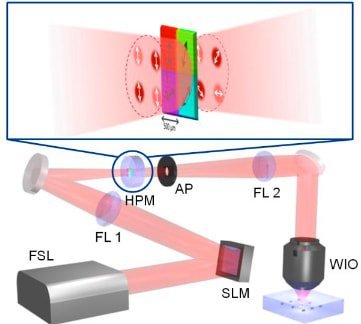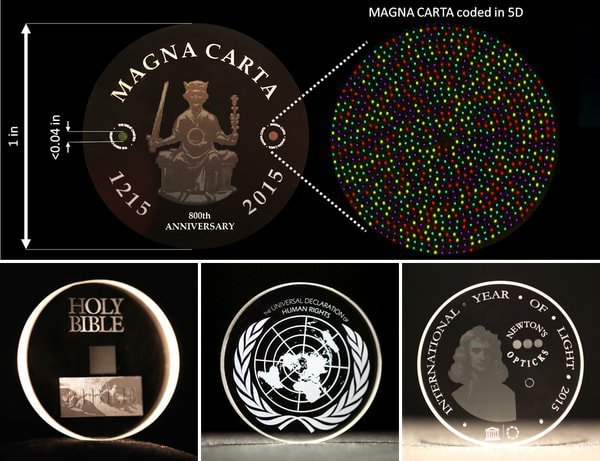Information on the threshold of immortality
This week on Habré already published an article about the eternal flash drive. We would like to continue the discussion by providing compiled material from several foreign sources telling about the immortal 
The discs themselves are small circles of 360Tb glass each. They can withstand temperatures up to 1000 ° C and be read for about 13.8 billion years at temperatures below 190 ° C. Files are recorded in three layers of nanostructured points located five micrometers apart; data is read when light passes through the glass. The storage device is called 5D, because the data is encrypted in size and orientation of the structures, as well as in three-dimensional space.
')
Unfortunately, the video was found only in the English version, but the essence is clear.
The researchers recorded the main documents - the Universal Declaration of Human Rights, the Charter of Liberties, the Bible of King James and the “Optics” of Isaac Newton on a new device, presenting it to UNESCO. Now this technology is gradually being commercialized, since it can be used by archivists all over the world, and it may be sent in a “time capsule” into space.
Nanostructures were discovered by chance during research on how light interacts with the material. The resulting storage device is characterized by high durability. Information cannot be destroyed even at high temperatures. There are other processes where higher densities can be achieved, but the developed storage device can break this record with its durability. In one of the articles, this find was called "information immortality."

Photo courtesy: spie.org
Each piece of information is located under the protection of the glass surface, which protects it from damage. The elements are only 20 nanometers (one billionth of a meter) in diameter, and the distance between two adjacent points is only 3.7 micrometers (millionths of a meter), which allows you to write a lot of information on such a small surface.

The ability to record data on nanostructured glass was discovered by Professor Kazan in 1996. Glass is chemically stable and resistant to chemical changes. It can also withstand temperatures up to 1000 ° C (1832 ° F) without degradation of the structure.
Internal studies have shown that even at elevated temperatures of 462K (370 ° C), the durability of the 5D disk will be billions of years. This means that

Photo courtesy: spie.org
The glass structure not only provides a stable structure, but is also an optimal material for recording data. A femtosecond laser is capable of creating nanostructures in glass at superfast speeds (femtosecond speed means one quadrillion per second). With the ability to give superintense light pulses and rebuild the glass from the inside, crystallizing it. The resulting crystals are highly durable and can be placed in the glass structure with incredible accuracy.
A traditional
The process of making an immortal flash drive
The flash drive 5D uses all known 3D technologies, but with the addition of two more dimensions. Having experimented, Professor Kazansky and his team managed to polarize the nanostructure, and using the “slow orientation of the axes”, change the speed of light passing through the material. These speed changes can be recorded as separate values, as the nano-lattice can represent 5 different values.
 Thus, each bit of information can be recorded in five different sizes, which allows you to store even more data in even smaller amounts. The technology will gradually be introduced to the market with the possibility of gradually reducing the price of the final product (of course, if the femtosecond laser becomes a bit cheaper). At the moment, equipment is very expensive, but the same can be said about any technology in the early stages. Not so long ago, hard drives were the size of a refrigerator and cost no less, but after the popularization and improvement of technology, their price fell, and everyone could use them.
Thus, each bit of information can be recorded in five different sizes, which allows you to store even more data in even smaller amounts. The technology will gradually be introduced to the market with the possibility of gradually reducing the price of the final product (of course, if the femtosecond laser becomes a bit cheaper). At the moment, equipment is very expensive, but the same can be said about any technology in the early stages. Not so long ago, hard drives were the size of a refrigerator and cost no less, but after the popularization and improvement of technology, their price fell, and everyone could use them.Photo credit: kurzweilai.net
Currently, Professor Kazan and his team are focused on using 5D technology for large-scale projects, such as building an “eternal archive” in Antarctica and creating a time capsule to be sent to Mars.
Well, perhaps, a technology has been created to store information for future generations, one that can, if necessary, provide the latest proof of the existence of our civilization.

Photo courtesy: theverge.com
Source: https://habr.com/ru/post/315982/
All Articles